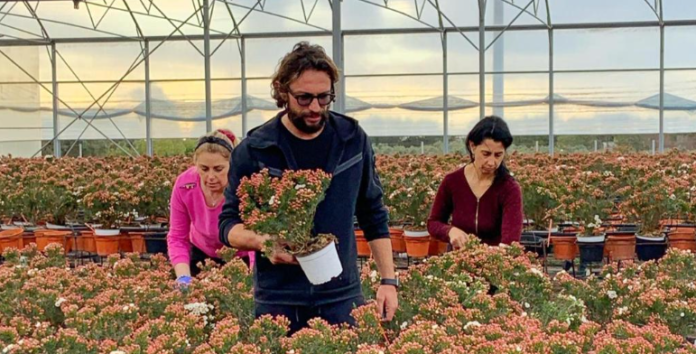Nestled in the heel of Italy’s boot, Florsilva is a five-hectare wholesale ornamental plant nursery priding itself on more than 20 years of experience in the propagation and production of potted waxflower, aka Chamelaucium uncinatum. According to business owner Silvano Verdesca, top-notch breeding research, consistency in product and service, international partnerships and passion are the best ways to thrive as a company.
When you walk into the 2-ha greenhouse of 46-year-old Silvano Verdesca, you notice the thousands of suspended pots in a raised metal wire framework. Growers of containerised nursery stock usually use these ‘pot stabilisers’ in the fields to avoid lightweight pots or taller containerised plants being blown away by strong winds.
Inside Florsilva’s greenhouse, however, reigns a windless calm, and these elevated plant beds primarily serve to provide proper air circulation and good drainage of pots. Growing unique Australian native plants such as potted Chamelaucium uncinatum comes with a unique set of challenges.
Trial and error
Verdesca is a plant grower from sun-drenched Copertino in Italy’s southern Apulia region, just as his father Francesco was before him. You can easily tell he was raised with the plants, understanding the business from cutting to retail. Yet, the pursuit was not straightforward when he began growing his first potted Chamelaucium uncinatum at the turn of the Millennium; the quest was not simple. He candidly admits,
“Initially, it was mainly trial and error, with only half of the plants surviving in the first year.”
Passion merged with perseverance, field expertise, and in-depth laboratory research best describes Verdesca’s commitment to growing native Australian plants in south-eastern Italy. “Year after year, you try different growing techniques until you have found something that really works,” says Verdesca, understandably, without revealing too much of what is behind his successful growing recipes.
He says it’s about finding the right balance between the size of the plant and the pot, the substrate, and the nutrition, and understanding the difference between well-drained, dry, and very dry.
Living up to international quality standards
Verdesca, who reckons he is only one of the three potted waxflower growers in Italy, explains that in his case, venturing into potted waxflower is what in corporate terms is called today ‘business resilience’; the ability to thrive and survive in an unpredictable and adverse business environment. “In its early years, Florsilva grew Australian native plants and a variety of Mediterranean plants, with Polygala myrtifolia occupying pride of place. Then, in 2013, the spectre of Xylella fastidiosa emerged in Apulia. The dreaded bacteria wreaked havoc in the region’s signature olive industry, causing thousands of trees to die. The research found Polygala myrtifolia and other Mediterranean plants susceptible to Xylella. Eventually, the species ended up in the EU’s database of Xyllela host plants, virtually halting all Polygala trade and forcing growers to ditch the ornamental crop. So, one can say that we turned a catastrophe into a blooming success.”
He continues, “Our company has come a long way from its humble beginnings in 2001. Looking back, I am most proud of the masses of flowers our plants produce, combined with a perfectly compact growth habit. These are the two most important prerequisites for successfully commercialising potted waxflower in the Italian and international marketplace.”
Verdesca owns and controls the propagation and cultivation of finished plants. “For years, Florsilva evolved into a fully-fledged Chamelaucium cutting farm, with the harvesting of plant parts from specially planted mother stock based on a sophisticated propagation process with exemplary hygiene standards.” Depending on the variety and pot size, workers place between one to three cuttings in a customised peat mix of Pindstrup. From cutting to saleable plant takes around 12 months undergoing several pruning.
Florsilva Nursery is situated in Copertino, the heart of the Salento area in Apulia. Here the temperate climate – there always seems to be a nice sea breeze – is much like the waxflower’s natural habitat and provides ideal growing.
Each year, the company produces well over 150,000 plants, across a range of Australian species, including Boronia, Grevillea (aka flowering Christmas tree), Pimilea, and potted Chamelaucium, in a range of pot sizes from 14cm to 17cm. Over half of the company’s annual output – 80,000 pots – accounts for potted Chamelaucium.
Helix Australia
Verdesca works with breeder and plant license company Helix Australia to bring its customers the best new Chamelaucium with tried and tested, more established varieties such as the relatively old cultivar ‘Snowflake’. “Today, ‘Snowflake’ is still prominently present in our portfolio. However, production-wise we wish to move towards the newer PBR-protected varieties of Helix Australia as they have improved yields, growth habits, colour, and desirable flowering season.”
Helix Australia invests in exciting breeding programmes with Kings Park and Botanic Garden (KPBG), Perth, Western Australia. Top-notch research by KPBG’s Digby Growns and his team resulted in a suite of fantastic waxflower hybrids.
Verdesca explains, “Our relationship with Helix Australia gives us access to top-notch waxflower research. Moreover, the company’s Adrian Parsons is arguably one of the best ambassadors of the global waxflower industry, always providing a big stimulus for trying out new varieties.”
Today, Florsilva grows four different varieties of potted waxflower: ‘Snowflake’ and Helix Australia breeds, including ‘Moonlight Delight’, ‘My Sweet16’, and ‘Sarah’s Delight’. “We are currently not considering any important crop switches. However, we would like to expand our production by adding new Helix varieties such as ‘Nina’s Delight’ and ‘Dee’s Delight’.”
The future is green
Now that climate change scorches the Northern and Southern hemispheres, Verdesca foresees a growing demand for trees and plants to help remove excess carbon from our atmosphere. So, he feels confident about the outlook for the new 2022/2023 selling season. He notes, “We are a green company culture. The future is green, and our ambition is to realise a cleaner world with beautiful and well-maintained urban green spaces. Australian plants have an essential role as they have evolved to survive drought and poor soils. They are extremely drought resistant and have a long shelf life.”
Florasilva looks forward to meeting you at forthcoming trade shows, such as Myplant in Italy in February 2023, where you can view the company’s range of potted chamelacuium in the stand of its commercial partners.







